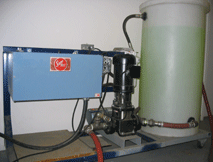I know that air temperature is controlled inside a wind tunnel, because the air heats and cools when compressed or expanded, and that is what happens on the "entrance impulsor" of the tunnel. I also know that this has been taken to extremes: Audi has a wind tunnel where they produce snow and rain to check for its influence.
http://www.designtaxi.com/news.jsp?id=1 ... &year=2008
I also find a couple of references to the study of heat sinks and heat flows in wind tunnels, one of them referring specifically to racing cars. These are the links (sorry, only abstracts, full articles cost money):
http://smartech.gatech.edu/handle/1853/17124 (nozzles for wind tunnels when you use heat sinks, for "global" temperature control of air)
http://www.ghtthx.com/WindTunnel.aspx (same thing: a heat exchanger design for global temperature control, some pictures)
Heat reservoir and pump to control air temperature

They can have a more complex control of temperature: this abstract shows you can build a thermally stratified flow (with wind shears induced by the changes in temperature you get depending on the height).
http://www.springerlink.com/content/n18m3097g652j433/
Now, what about testing heat producing parts in a model? The only references I got were these:
http://news.thomasnet.com/fullstory/463126 (small wind tunnel to test computer boards, by Advanced Thermal solutions)
Really small wind tunnel, it has some plastic windows to check for smoke trails
 http://ieeexplore.ieee.org/xpl/freeabs_ ... mber=18078
http://ieeexplore.ieee.org/xpl/freeabs_ ... mber=18078 (another abstract about designing heat sinks for computers)
http://speedarticles.com/auto_racing_article-4.html (small article on wind tunnels
used for radiator design)
Now, a third class of references: CFD is used to estimate heat flows. I quote:
"CFD is used by nearly every Formula One racing team to optimize the aerodynamics of vehicle bodies and design other parts where fluid flow
or heat transfer is critical."
http://www.flomerics.com/casestudies/de ... hp?id=1300
These colours indicate pressure or speed, not temperature, but the model takes in account heat sinks

It seems you can, beside temperature, take in account the exhaust pressure. I found this reference:
"At some stage, the boundary conditions of the problem have to be imposed... Other similarly treated parts of the model might be...
heat sources with temperatures (for the radiator faces), and pressure boundaries (for the duct exhaust)."
http://autospeed.com/cms/A_109131/article.html
Finally, I found a couple of references to Shuttle tiles (the ones that kept at bay the heat of reentry) being used in NASCAR and, of course, being tested beforehand in a wind tunnel.
http://findarticles.com/p/articles/mi_q ... i_n8879904
Can you believe this? 3M makes paper that can stop the flames, to be used in NASCAR vehicles!

I imagine you could use a suit made of paper to offset the weight of a cockpit surrounded with tiles...

(actually, I think that the shuttle tiles are quite light for its heat blocking ability: putting weight into space can cost you a kidney).










